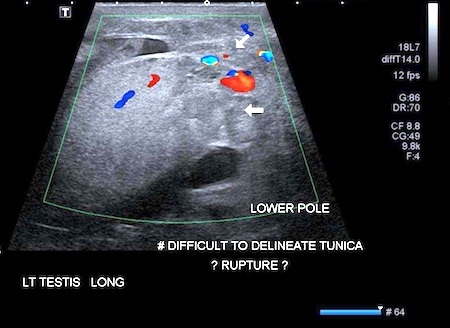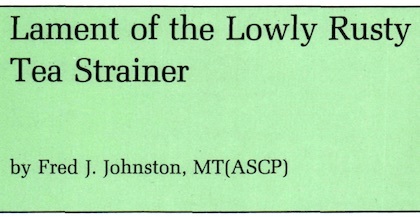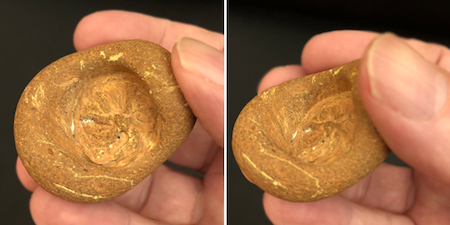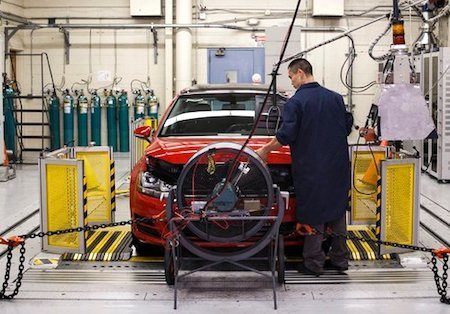Marc Abrahams's Blog, page 196
February 7, 2018
Can Scrotal Gunshot Wound Result in Testicular Injury? [research study]
Persons outside the professional medical world may be unfamiliar with the acronym “SGSW.” A new study may, as a side-effect, help such persons remember that item of information:
“Utility of Preoperative Ultrasound for the Evaluation of Testicular Rupture in the Setting of Scrotal Gun Shot Wounds,” Ryan Powers, Stephen Hurley, Edward Park, Brian McArdle, Patricia Vidal, Sarah P. Psutka, and Courtney M.P. Hollowell, Journal of Urology, epub 2018. (Thanks to Ivan Oransky for bringing this to our attention.) The authors, at John H. Stroger Jr. Hospital of Cook County, and at Northwestern University, report:
“Scrotal Gunshot Wound (SGSW) may result in testicular injury…”
Here is a further detail from the study:

February 6, 2018
Where and When Snow Comes Off a Moving Train
The snowfall from a snow-laden (from a snowfall) train is somewhat predictable—and so can be somewhat controlled, suggests this study:
“Studies of Snow-Dropping from a Train on a Turnout due to Dynamic Excitations,” Tiia-Riikka Loponen, Pekka Salmenperä, Heikki Luomala, and Antti Nurmikolu, Journal of Cold Regions Engineering, vol. 32, no. 2, June 2018. The authors, at Tampere University of Technology, Finland, report:
Snow accumulated on a train underframe may detach itself in places where rail discontinuity causes an excitation to the train. In turnout areas, this may cause serious problems when snow buildup from beneath the rolling stock drops into the gap between the switch blade and the stock rail and disrupts the turnout operation….

Based on the research results, it can be said that turnouts are a considerable cause of vibration in rolling stock. Should snow accumulate on the rolling stock and detach itself exactly due to excitation originating from a point of discontinuity of the rail, the snow is likely to drop at the location of a turnout. It was clearly observed in 2009–2010 that snow tends to drop from rolling stock in turnout areas; this means that, in adverse weather conditions, the acceleration levels created at turnout locations are sufficient to drop snow from rolling stock. The acceleration levels established by the measurements may therefore be used to develop methods to drop the snow, such as introducing intentional points of discontinuity in the rail to drop snow from the rolling stock.
(Thanks to Tom Gill for bringing this to our attention.)

February 5, 2018
Improving our understanding of Bamboozle Structures
It’s not everyday that a newly discovered 3-D mathematical concept appears on the topological horizon. But one did in 2012. It’s called the Bamboozle Structure.
“Bamboozle consists of 51 equilateral triangles, meeting pairwise at an angle of about 70.5 degrees (arccos 1/3).”
It seems that topologists haven’t given a great deal of consideration to Bamboozle Structures since their discovery, but Timo Scholte (Eindhoven University of Technology, The Netherlands) is an exception.
See: ‘Bamboozle Structures and Honeycombs’
“Since bamboozle structures are a relatively new concept that have so far strictly been viewed as single orbits under space groups, there are still possibilities to improve our understanding of such structures. In this thesis, we relate bamboozle structures to tessellations of three dimensional Euclidean space, namely convex uniform honeycombs. This is done by relating the problem to its two dimensional equivalent, identifying what convex uniform honeycombs hold (near-)bamboozle structures, proving of completeness of the list of used convex uniform honeycombs with the help of computer calculations, and considering what adjustments convex uniform honeycombs can withstand in order to create bamboozle structures. Though the search for new bamboozle structures proved unfruitful, we found that the hexagonal bamboozle structure was in fact not a bamboozle structure, discovered that the square bamboozle structure and the four-coloured rectangular bamboozle structure actually form continuous families, and gained a better understanding of the bamboozle structure and what areas should be considered to find a complete list of possible structures.”

February 1, 2018
Misplace apostrophes – miss out on med school?
The perennially thorny issue of apostrophe misuse has been correlated with lack-of-success at medical school. Researchers Dr Michael Cop and Dr Hunter Hatfield of the University of Otago, New Zealand, decided to test whether undergraduate medical students’ abilities in handling apostrophes might be linked to their (future) career prospects :
“
We therefore examined the placement offers for each of the students who wrote sentences requiring possessive apostrophes. The placement rate for those who used the apostrophe correctly was 43%, while for those who used it incorrectly it was only 31%. In logistic regression, this difference was significant (Wald’s z = −2.211, p = 0.027). Students who placed the possessive apostrophe correctly were 38% more likely to be offered a place. Strangely, this little mark seems to have some predictive abilities of whether or not students will succeed in becoming health professionals.”
See: An athletes [sic] performance: Can a possessive apostrophe predict success?: Misplace apostrophes, miss out on med school? English Today, Volume 33, Issue 3, September 2017 , pp. 39-45.
Notes:
[1] The paper cites the much celebrated 2003 book by Lynne Truss ‘Eats, Shoots & Leaves: The Zero Tolerance Approach to Punctuation’.
[2] Apostrophes don’t often feature in mainstream media news headlines – but 2018 is already proving an exception. See this item from the New York Times regarding the president of Kazakhstan’s new rules for apostrophes :
“In a country where almost nobody challenges the president publicly, Mr. Nazarbayev has found his policy on apostrophes assailed from all sides.”
[3] The 2001 Ig Nobel Prize for literature was awarded to John Richards of Boston, England, founder of The Apostrophe Protection Society, for his efforts to protect, promote, and defend the differences between plural and possessive.

January 31, 2018
‘Lament of the Lowly Rusty Tea Strainer’
Drink in, if you will, these highlights from the poem “Lament of the Lowly Rusty Tea Strainer,” by Fred J. Johnston, published in the journal Laboratory Medicine (Volume 11, Issue 6, 1 June 1980):
…So oft have I been clogged with crud
That’s mixed with tarry clotted blood.
I’ve often seen a tapeworm dead
And helped to find its scolex head….
…When kidneys failed and stones were free,
Much amber liquid flowed through me.
Those gorgeous gallstones, golden-green,
Have often flowed within my screen.
No cloak of gold I’ll e’er be dressed
To cover up this rusty crust.
My service now has come to rest;
I bear no medals on my breast.
Alas! I know it can never be
That I’ll be used for brewing tea!

January 30, 2018
What things might or might not mean, to unknown (maybe unknowable) observers
Stephen Wolfram offers a raft of things that might or might have meanings. Wolfram also offers thoughts on whether those meanings—if they are meanings—were intended to mean what we may think they might mean.
This is part of Wolfram meandering down mean streets of thought about whether and how it’s possible to make things that would be meaningful to people (or whatever) from utterly different places and times. Aliens from somewhere way across the universe, for example.
The thought-piece is called “Showing Off to the Universe: Beacons for the Afterlife of Our Civilization.” Here’s one of its examples:
Almost exactly 50 years ago, as a young child vacationing in Sicily, I picked up this object on a beach:
Being very curious what it was, I took it to my local archaeology museum. “You’ve come to the wrong place, young man,” they said, “it’s obviously a natural object.” So off I went to a natural history museum, only to be greeted with “Sorry, it’s not for us; it’s an artifact”. And from then until now the mystery has remained (though with modern materials analysis techniques it could perhaps be resolved—and I obviously should do it!)

January 29, 2018
Three concepts of monstrosity
“
What is a monster? At least three concepts have been proposed: Aristotle thinks a monster to be a “mistake of purpose” in nature; Noël Carroll thinks a monster to be a scientifically impossible being that arouses disgust and fear; Cynthia Freeland thinks a monster to be an evil being. Thus a two-headed calf is an Aristotelian monster; a werewolf a monster on Carroll’s definition; and Norman Bates of Hitchcock’s Psycho a monster on Freeland’s concept. These have no interesting overlaps.”
So wrote Robert (Bob) Yanal, Professor Emeritus of Philosophy at Wayne State University, Detroit, in the journal Contemporary Aesthetics, Volume 1, 2003, ‘Two Monsters in Search of a Concept’
The professor’s website, featuring many other publications and photos, can be found at bobyanal.wordpress.com

January 26, 2018
Underplayed redundancy in placebo effect research (on cheap vs costly fake medicine)

Alberto J. Espay, M.D., lead author of the later study
A celebrated 2015 research paper makes much the same discovery as a paper that won an Ig Nobel Prize for medicine years earlier. The discovery is about the power of pricing fake medicines. The new paper makes only an indirect, beery allusion to the earlier, Ig Nobel Prize-winning research.
That 2008 Ig Nobel Prize for medicine was awarded to Dan Ariely, Rebecca L. Waber, Baba Shiv, and Ziv Carmon, for demonstrating that high-priced fake medicine is more effective than low-priced fake medicine. Their prize-winning paper is “Commercial Features of Placebo and Therapeutic Efficacy,” Rebecca L. Waber; Baba Shiv; Ziv Carmon; Dan Ariely, Journal of the American Medical Association, March 5, 2008; 299: 1016-1017.
The more recent published study is: “Placebo effect of medication cost in Parkinson disease—A randomized double-blind study,” Alberto J. Espay [pictured here], Matthew M. Norris, James C. Eliassen, Alok Dwivedi, Matthew S. Smith, Christi Banks, Jane B. Allendorfer, Anthony E. Lang, David E. Fleck, Michael J. Linke, and Jerzy P. Szaflarski, Neurology, vol. 84, no. 8, 2015.
[EDITOR’S NOTE: In the first version of this blog item we had the dates scrambled. Sorry about that!]
The newer paper does cite one of the Ig Nobel Prize-winning authors (Dan Ariely), but indirectly, in this footnote allusion:
Lee L, Frederick S, Ariely D. “Try it, you’ll like it: the influence of expectation, consumption, and revelation on preferences for beer. Psychol Sci 2006;17:1054–1058.
The Los Angeles Times did a report about the new report, with the headline ” ‘Expensive’ placebos work better than ‘cheap’ ones, study finds.” The news report about the medical report says:
How do you convert a simple saline solution into a useful treatment for people with Parkinson’s disease? Tell them it’s a drug that costs $100 per dose. And if you want to make it even more effective, tell them it costs $1,500 instead.
That’s what researchers from the University of Cincinnati discovered in an unusual clinical trial. Instead of testing a placebo against an actual drug, they pitted two placebos against each other. The only difference between the two sham treatments was their purported price….
“Placebo can be the physician’s friend,” a pair of neurologists wrote an editorial that accompanied the study. “The outcome of this study … opens our eyes to another nuance of placebo effect.”
(Thanks to Scott Langill for bringing this to our attention.)

Effects of Various Music on Angry Automobile Drivers
The effects of different styles of music on angry automobile drivers were analyzed, to some extent, in this study:
“The Effects of Various Music on Angry Drivers’ Subjective, Behavioral, and Physiological States,” Maryam FakhrHosseini and Myounghoon Jeon, Proceedings of the 8th International Conference on Automotive User Interfaces and Interactive Vehicular Applications Adjunct, pp. 191-196. ACM, 2016.
The authors, at Michigan Technological University, report: “Angry drivers with self-selected music showed more aggressive driving behavior.”

January 25, 2018
Volkswagen’s Ig Nobel Prize-winning research also used cartoon-watching monkeys
The research that won an Ig Nobel Chemistry Prize for Volkswagen also involved monkeys watching cartoons while they inhaled automobile fumes — a fact that was not publicly known at the time the prize was awarded. Nor was it known to the Ig Nobel Board of Governors. The monkeys/cartoons news was reported today by Jack Ewing, in the New York Times, with the headline “10 Monkeys and a Beetle: Inside VW’s Campaign for ‘Clean Diesel’. ” That report begins:
FRANKFURT — In 2014, as evidence mounted about the harmful effects of diesel exhaust on human health, scientists in an Albuquerque laboratory conducted an unusual experiment: Ten monkeys squatted in airtight chambers, watching cartoons for entertainment as they inhaled fumes from a diesel Volkswagen Beetle.
German automakers had financed the experiment in a bid to prove that diesel vehicles with the latest technology were cleaner than the smoky models of old. But the American scientists conducting the test were unaware of one critical fact: The Beetle provided by Volkswagen had been rigged to produce pollution levels that were far less harmful in the lab than they were on the road….
That 2016 Ig Nobel Prize for chemistry was awarded to Volkswagen, for solving the problem of excessive automobile pollution emissions by automatically, electromechanically producing fewer emissions whenever the cars are being tested.
REFERENCE FOR THE 2016 PRIZE ANNOUNCEMENT: “EPA, California Notify Volkswagen of Clean Air Act Violations“, U.S. Environmental Protection Agency (EPA) news release, September 18, 2015. [NOTE: The EPA recently moved or removed that news release from its original location on the EPA web site. The link we give here is the original link.]
BONUS: Additional news today, about a different Ig Nobel Prize winner.
BONUS: And here’s some news from 2015 about the Albuquerque laboratory that reportedly did the monkey/cartoons/fumes research.

Marc Abrahams's Blog
- Marc Abrahams's profile
- 14 followers









